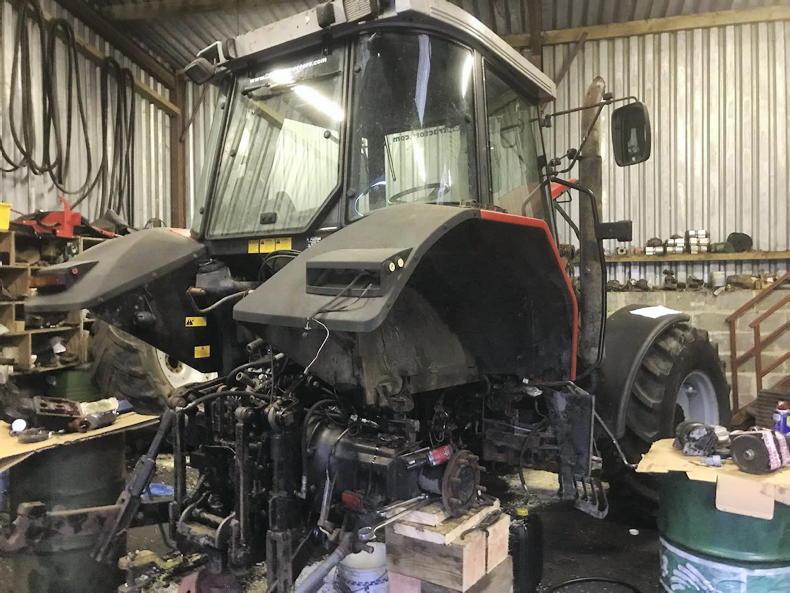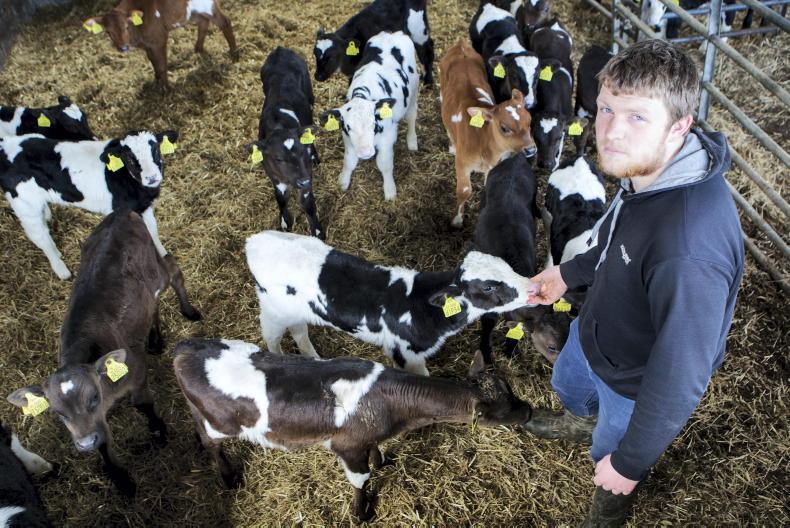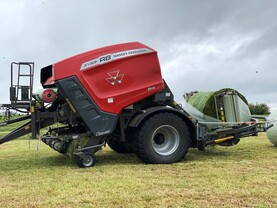Farmers and non-farmers from around the world have been following machinery, contracting, tillage and dairy calf to beef videos from Irish agriculture’s YouTube star Philip Stewart.
The Longford man has accumulated some 54,000 subscribers on his YouTube channel Farmer Phil.
The channel secures 850,000 video views a month from an Irish (55%), UK (30%), US (2.2%), Dutch (1.2%) and Australian (1%) audience.
In peak contracting season over the spring and summer, Philip’s videos reach as high as 1.5m cumulative views in a 28-day period.
He farms 540ac of mostly fragmented and rented land outside Killashee, Co Longford, with his father Derek, uncle Ian and fiancée Olivia. His mother Diane supports on all of the farm paperwork.
Starting out
In an interview with the Irish Farmers Journal, Philip described how himself and a friend started getting into YouTube in 2015 for a “bit of craic”.
What originally started out “as a joke” took a while to develop into the farm diversification mechanism it is today.
“For three years, I was chasing my tail and it never went anywhere. Only in 2019, the channel started to get going.”
By the end of 2020, we’d reached 34,000 and there’s been another 20,000 in 2021
His approach of demonstrating real life farming where he simply “put the phone in the windscreen and talked away to the camera”, began to gain popularity.
“It took me five years to get to 10,000 subscribers and the six months to March 2020 to get to 20,000.
“By the end of 2020, we’d reached 34,000 and there’s been another 20,000 in 2021.”
Family affair
The work now involved in maintaining the Farmer Phil channel means all the family have a role to play.
Philip, who was self-taught through watching YouTube videos, originally did all his own editing but this work has since been taken up by his fiancée Olivia.
Diet feeding the cattle can take two hours but if you want to film it, it can take as much as three and a half hours
Stewart instead focuses on the filming and between set up for three weekly videos and camera time, it can take up to 12 hours a week.
“For any 20-26-minute video, you need an hour or so of footage. To make a good video, you’re getting the best angle and shot.

Followers can watch videos of tractors and other farm machinery being worked on in the Stewart farm workshop.
“Diet feeding the cattle can take two hours but if you want to film it, it can take as much as three and a half hours.”
Olivia matches the video the music, cuts down the footage and the finished cuts are published every Tuesday, Thursday and Sunday.
Farm system
Providing content that fills the videos, the Stewarts run a mixed farm system including tillage and dairy calf to beef.
“We grow 240ac of tillage including wheat, oats, barley, beans and maize. We grow the tillage to finish the cattle and have our own straw.
“We’re nearly self-sufficient with minerals and biscuit meal being the only things bought in.”
Philip described how every spring 340-400 calves are bought in for rearing to beef.

Stewart says the machinery videos are a hit with most of his followers.
The wide range of breeds include Friesian, Angus, Hereford, Jersey, Limousine and Aubrac with two thirds being dairy sired and the other third being beef sired.
“We fill the farm in the space of three to four weeks. If a farmer has a pen of them, we take them all, not just the best ones.”
The Stewarts have two automatic milk feeders and the calves are put out to rotational grazing for the summer.
Kept over two winters, bulls are finished under 24 months, bullocks under 25 and heifers under 26. A small number are slaughtered off-farm and returned to be sold through a new aspect of the business, a farm shop set up in February 2021.
Contracting
The Stewarts provide a contracting service to local farmers for slurry spreading, baled and pit silage, topping and all areas of farm machinery work.
“The only thing we don’t do is hedge cutting,” says Philip.
He explained how the machinery videos always get more views.
“The cattle and machinery men will watch the machinery videos but the machinery lads won’t watch the cattle ones.”

Philip Stewart checking on his young calves. Stewart features the rearing and finishing process on his YouTube channel.
Philip’s videos include footage of the various contracting work and discussion on the machinery used. His father Derek also participates in videos featuring maintenance work.
“We’re 20 years at the pipes (umbilical slurry spreading) and there’s a great interest in that.”
He aims to show the whole process, start to finish, for each contracting job to help inform farmers.
Audience
The Longford man says many of his followers are people from all over the world who come from a farming background but aren’t actively farming. He says they have a yearning for the past and to see how it all works still.
“I definitely see myself as educating non-farmers. I get messages from people all over the world.”
More recently, Philip has connected with beef consumers through the page. He says they can see the full process of rearing the dairy beef calf and then order the beef through the on-farm shop.
He said he is sending boxes of beef with full traceability all over Ireland at the moment.
YouTube
Stewart explained how YouTube provides “a good wage” which is “definitely worth your while”.
“The rate I’ve got paid at has increased four-fold since the channel began.”
He explained how the YouTube pricing model, cost per 1,000 impressions (CPM), works out at €8 per thousand “monetised views”.
On how well his channel is doing, Stewart says the “subscriber count is more of a milestone than a marker” and that performance is “down to the video views”.
“What I see in my own channel is that the rate [of increase] may slow down. You just take it as it comes.”
YouTube has developed a unique model within the industry of revenue-sharing directly with creators
A spokesperson for YouTube said it is “very much a part of and driving the [Irish] creative economy forward”.
“YouTube has developed a unique model within the industry of revenue-sharing directly with creators.”
Stewart also receives sponsorship and demos from agri companies which he promotes through his channel.
On why farmers should follow Farmer Phil, Philip said: “There’s something for everyone. We cover it all.”
Farmers and non-farmers from around the world have been following machinery, contracting, tillage and dairy calf to beef videos from Irish agriculture’s YouTube star Philip Stewart.
The Longford man has accumulated some 54,000 subscribers on his YouTube channel Farmer Phil.
The channel secures 850,000 video views a month from an Irish (55%), UK (30%), US (2.2%), Dutch (1.2%) and Australian (1%) audience.
In peak contracting season over the spring and summer, Philip’s videos reach as high as 1.5m cumulative views in a 28-day period.
He farms 540ac of mostly fragmented and rented land outside Killashee, Co Longford, with his father Derek, uncle Ian and fiancée Olivia. His mother Diane supports on all of the farm paperwork.
Starting out
In an interview with the Irish Farmers Journal, Philip described how himself and a friend started getting into YouTube in 2015 for a “bit of craic”.
What originally started out “as a joke” took a while to develop into the farm diversification mechanism it is today.
“For three years, I was chasing my tail and it never went anywhere. Only in 2019, the channel started to get going.”
By the end of 2020, we’d reached 34,000 and there’s been another 20,000 in 2021
His approach of demonstrating real life farming where he simply “put the phone in the windscreen and talked away to the camera”, began to gain popularity.
“It took me five years to get to 10,000 subscribers and the six months to March 2020 to get to 20,000.
“By the end of 2020, we’d reached 34,000 and there’s been another 20,000 in 2021.”
Family affair
The work now involved in maintaining the Farmer Phil channel means all the family have a role to play.
Philip, who was self-taught through watching YouTube videos, originally did all his own editing but this work has since been taken up by his fiancée Olivia.
Diet feeding the cattle can take two hours but if you want to film it, it can take as much as three and a half hours
Stewart instead focuses on the filming and between set up for three weekly videos and camera time, it can take up to 12 hours a week.
“For any 20-26-minute video, you need an hour or so of footage. To make a good video, you’re getting the best angle and shot.

Followers can watch videos of tractors and other farm machinery being worked on in the Stewart farm workshop.
“Diet feeding the cattle can take two hours but if you want to film it, it can take as much as three and a half hours.”
Olivia matches the video the music, cuts down the footage and the finished cuts are published every Tuesday, Thursday and Sunday.
Farm system
Providing content that fills the videos, the Stewarts run a mixed farm system including tillage and dairy calf to beef.
“We grow 240ac of tillage including wheat, oats, barley, beans and maize. We grow the tillage to finish the cattle and have our own straw.
“We’re nearly self-sufficient with minerals and biscuit meal being the only things bought in.”
Philip described how every spring 340-400 calves are bought in for rearing to beef.

Stewart says the machinery videos are a hit with most of his followers.
The wide range of breeds include Friesian, Angus, Hereford, Jersey, Limousine and Aubrac with two thirds being dairy sired and the other third being beef sired.
“We fill the farm in the space of three to four weeks. If a farmer has a pen of them, we take them all, not just the best ones.”
The Stewarts have two automatic milk feeders and the calves are put out to rotational grazing for the summer.
Kept over two winters, bulls are finished under 24 months, bullocks under 25 and heifers under 26. A small number are slaughtered off-farm and returned to be sold through a new aspect of the business, a farm shop set up in February 2021.
Contracting
The Stewarts provide a contracting service to local farmers for slurry spreading, baled and pit silage, topping and all areas of farm machinery work.
“The only thing we don’t do is hedge cutting,” says Philip.
He explained how the machinery videos always get more views.
“The cattle and machinery men will watch the machinery videos but the machinery lads won’t watch the cattle ones.”

Philip Stewart checking on his young calves. Stewart features the rearing and finishing process on his YouTube channel.
Philip’s videos include footage of the various contracting work and discussion on the machinery used. His father Derek also participates in videos featuring maintenance work.
“We’re 20 years at the pipes (umbilical slurry spreading) and there’s a great interest in that.”
He aims to show the whole process, start to finish, for each contracting job to help inform farmers.
Audience
The Longford man says many of his followers are people from all over the world who come from a farming background but aren’t actively farming. He says they have a yearning for the past and to see how it all works still.
“I definitely see myself as educating non-farmers. I get messages from people all over the world.”
More recently, Philip has connected with beef consumers through the page. He says they can see the full process of rearing the dairy beef calf and then order the beef through the on-farm shop.
He said he is sending boxes of beef with full traceability all over Ireland at the moment.
YouTube
Stewart explained how YouTube provides “a good wage” which is “definitely worth your while”.
“The rate I’ve got paid at has increased four-fold since the channel began.”
He explained how the YouTube pricing model, cost per 1,000 impressions (CPM), works out at €8 per thousand “monetised views”.
On how well his channel is doing, Stewart says the “subscriber count is more of a milestone than a marker” and that performance is “down to the video views”.
“What I see in my own channel is that the rate [of increase] may slow down. You just take it as it comes.”
YouTube has developed a unique model within the industry of revenue-sharing directly with creators
A spokesperson for YouTube said it is “very much a part of and driving the [Irish] creative economy forward”.
“YouTube has developed a unique model within the industry of revenue-sharing directly with creators.”
Stewart also receives sponsorship and demos from agri companies which he promotes through his channel.
On why farmers should follow Farmer Phil, Philip said: “There’s something for everyone. We cover it all.”









 This is a subscriber-only article
This is a subscriber-only article









SHARING OPTIONS: